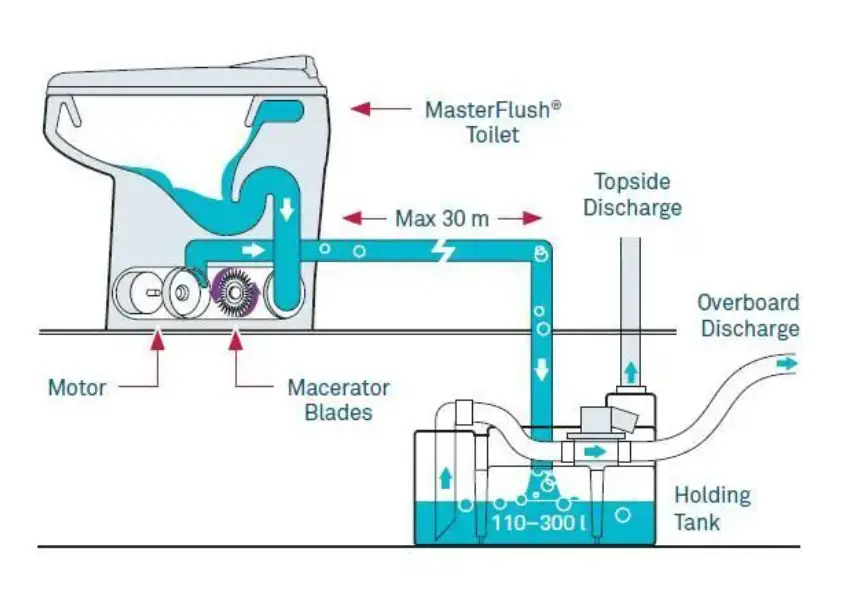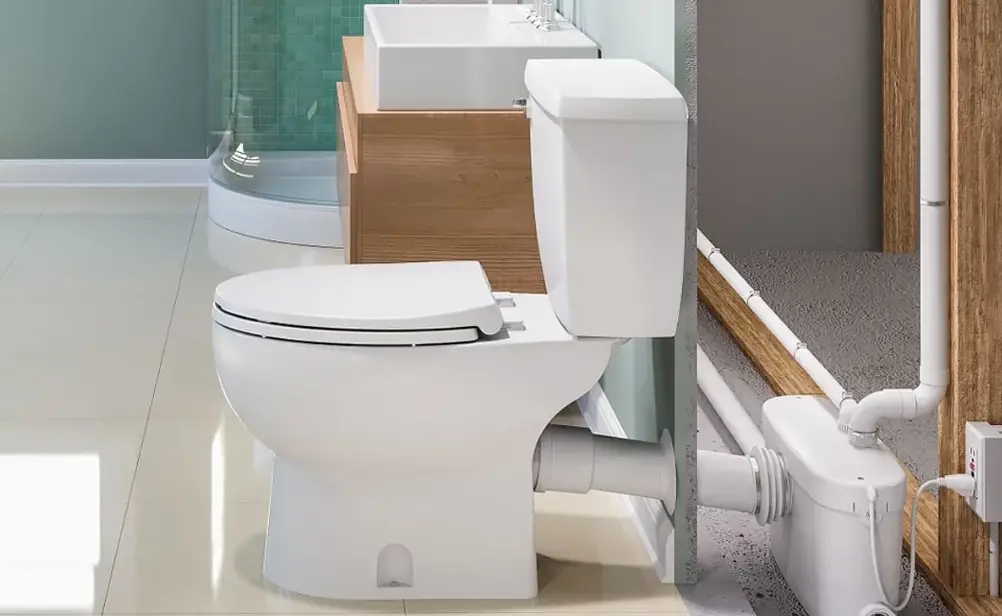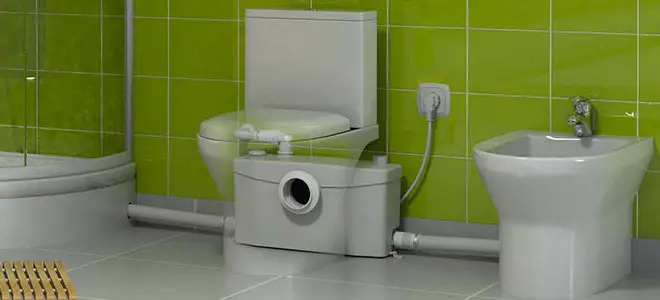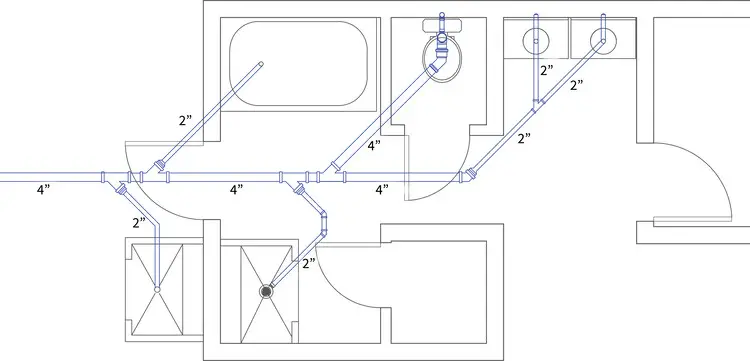Macerating toilets are a unique option that some people choose for their home. If you are not familiar with them, read on to learn everything you need to know about this type of toilet. Macerating toilets are designed to handle waste in a more efficient way than traditional options. They can be a great choice for people who have limited space in their home or who live in an area that is prone to flooding.
How Macerating Toilets Work?
Macerating toilets are unique in the way they operate. Rather than using water to move waste through the sewer lines, these toilets use a macerator. This is a grinding tool that pulverizes solid waste so that it can be easily flushed through small diameter pipes.

Macerating toilets are also known as upflush toilets because they pump waste up to the sewer line rather than down like traditional toilets. This makes them ideal for locations where gravity drains are not an option, such as in basement bathrooms.
One of the benefits of macerating toilets is that they require less water to operate than traditional toilets. They also do not require special large-diameter drainage pipes, which can save on installation costs. [1]
When To Choose A Macerating Toilet?
Macerating toilets are a great option for anyone who wants to have a toilet in their home but doesn’t have the proper plumbing. These toilets macerate, or grind up, waste so that it can be flushed through a small diameter pipe. This makes them perfect for places where traditional toilets wouldn’t work, such as in a basement or an addition to your home.
There are a few things to keep in mind when choosing a macerating toilet. First, you’ll need to make sure that the space you have available can accommodate the larger size of these toilets. Second, you’ll want to think about how often you’ll need to use the toilet.
Pros Of Macerating Toilets

Flexibility
If you need to put a bathroom in an unconventional location, a macerating toilet will give you the most options. You’re not limited by where your sewer line is located because the waste goes into a holding tank that can be located virtually anywhere.
Easy Installation
Most macerating toilets come as a complete kit that includes everything you need for installation. This makes it a relatively easy do-it-yourself project.
Low Water Usage
Macerating toilets use very little water, typically around 0.125 gallons per flush. This is great news if you’re on septic or have water restrictions in your area.

Convenience
Macerating toilets are very convenient. They have the same flushing power as a standard toilet, so you don’t have to worry about waste building up in the bowl.
Lack Of Odor
Macerating toilets don’t produce any odor because the waste is immediately flushed away and doesn’t have a chance to sit in the bowl.
More Traditional Throne
If you’re worried about a macerating toilet not feeling like a “real” toilet, don’t be. Many manufacturers have come out with models that look and feel just like a standard flush toilet.
Clog Prevention
Macerating toilets are much less likely to become clogged because the waste is chopped up before it goes into the holding tank. This means that even if something does get stuck, it’s much less likely to cause a major blockage. [2]
Cons Of Macerating Toilets
Upfront Cost
The cost of a macerating toilet is significantly higher than that of a traditional toilet. [3]
Noisy
Maintenance
Macerating toilets require more maintenance than traditional toilets. You’ll need to regularly check and clean the macerating unit to prevent clogs and other problems.
More Moving Parts Involved
Since there are more moving parts involved in a macerating toilet, there’s a greater chance that something could go wrong. If one of the parts breaks, you’ll need to hire a professional to fix it.
Requires Electricity
Macerating toilets require electricity to operate, so if there’s a power outage, you’ll be without a toilet.
Toilet Sensor Can Prevent Flushing
If something goes wrong with the toilet sensor, it can prevent the toilet from flushing. This can be a major inconvenience, especially if you have guests over.
How To Plan Your Plumbing?
If you’re considering adding a macerating toilet to your home, there are a few things you should know about this unique option.

Macerating toilets are becoming increasingly popular in homes where traditional sewer lines cannot be used. Here’s everything you need to know about macerating toilets, from how they work to whether or not they’re right for your home.
Macerating toilets work by grinding up waste and flushing it out through a small pipe. This type of toilet is ideal for homes that have limited space for sewage lines. They can also be used in homes that are located far away from the main sewer line.
One of the benefits of macerating toilets is that they require less water than traditional toilets. They also don’t require the use of harsh chemicals to break down waste. However, there are some drawbacks to using this type of toilet.
There are many factors to consider when choosing a toilet for your home. But with a little research, you can find the perfect option for your needs. Macerating toilets offer many benefits and can be a great addition to any home. Just be sure to do your homework before making a final decision!
How To Install Macerating Toilets?
Macerating toilets are also relatively easy to install, making them a good option for do-it-yourselfers. Here’s what you need to know about installing macerating toilets:
The first thing you need to do is find the location of your nearest toilet supply store. Once you’ve found a store, you’ll need to purchase a macerator kit. Most kits come with everything you need to install the toilet, including the macerator itself, a discharge pipe, and an instruction manual.
Once you have your kit, the next thing you need to do is turn off the water supply to your toilet. Next, flush the toilet to empty the bowl of any remaining water. Once the bowl is empty, disconnect the supply line from the tank and remove the tank from the bowl.
With the tank removed, you’ll be able to access the bolts that hold the bowl to the floor. Remove these bolts and lift the bowl off of the floor. Now would also be a good time to clean up any old caulk or grime around where the bowl was attached to help ensure a tight seal when you reinstall it.
Next, you’ll need to reconnect the water supply line to the tank and fill it with water. Once the tank is full, turn on the water supply and flush the toilet a few times to test it out. If everything is working properly, you should now have a fully functional macerating toilet! Congratulations! [4]
What About Maintenance?
Macerating toilets are generally very low maintenance. The macerator and pump are sealed units that require little to no attention. It is important to keep the discharge pipe clean and free of any blockages. Occasionally, the blades will need to be replaced. Other than that, these toilets should give you years of trouble-free use. [5]
FAQ
Are macerator toilets reliable?
Macerator toilets are generally reliable, but as with any type of toilet, there can be occasional problems. The most common issue is a clog in the macerator pump or one of the pipes. This can usually be fixed by simply clearing the obstruction. Another potential issue is a leak in the macerating unit itself. This is not as common, but if it does happen, it will need to be repaired or replaced.
What are some advantages of macerating toilets?
There are several advantages to using a macerating toilet. One is that they take up less space than traditional toilets since there is no need for a large water tank. They are also very easy to install, even in homes that do not have a sewer line. Additionally, macerating toilets are much more efficient than traditional toilets, using less water per flush.
What are some disadvantages of macerating toilets?
There are a few potential disadvantages to using a macerating toilet. One is that they can be more expensive than traditional toilets. Additionally, if there is a power outage, the macerator will not work and the toilet will not be able to be used. Finally, if there is a clog or leak in the system, it can be difficult to repair.
How long do macerator toilets last?
Macerating toilets can last for many years, as long as they are properly maintained. However, like any other type of toilet, there are certain parts that may need to be replaced periodically. The most common parts that need to be replaced are the macerator blades and the seals. If you keep your macerating toilet well-maintained, it should provide you with years of reliable use.

What can go wrong with a macerator toilet?
If you have a macerator toilet, there are a few things that can go wrong. The most common problem is that the blades in the macerator get clogged with toilet paper. This can cause the toilet to flush slowly or not at all. If you notice that your toilet is flushing slowly, you should check the blades in the macerator to see if they need to be cleaned.
Another problem that can occur is that the motor in the macerator can burn out. This usually happens because of a build-up of lint and hair around the blades. If you notice that your toilet is not flushing at all, it is probably because the motor has burned out and will need to be replaced.
Lastly, the macerator can leak. This is usually because the seals around the blades are not tight enough.
Where does the waste go from a macerator toilet?
Macerating toilets are unique in that they have the ability to grind up waste and pump it out through a small diameter pipe. This makes them ideal for installations where a conventional sewer connection is not available. But, where does the waste go once it has been ground up? There are three main options for disposing of waste from a macerator toilet:
- into an existing sewer system
- into a septic tank
- onto land away from any water sources
Each option has its own set of pros and cons that should be considered before making a decision. For example, connecting to an existing sewer system may not be possible if the property is not served by one. And, discharging onto land may not be feasible if the property is not large enough or if there are water sources nearby. The best option for disposing of waste from a macerator toilet will vary depending on the specific circumstances of each installation. A qualified plumber or septic designer should be consulted to determine the best option for your situation.
Can I put bleach down a macerator toilet?
One of the most common questions we get about macerating toilets is whether or not you can put bleach down them. The answer is yes, but you should use caution when doing so. Bleach is a powerful chemical and can damage the blades on your macerator toilet if used too frequently. We recommend using bleach only as a last resort for cleaning your macerator toilet. If you do use bleach, be sure to flush several times afterwards to clear any residual bleach from the system.
Does a macerating toilet need to be vented?
Macerating toilets do not need to be vented like standard toilets because they do not rely on gravity to function. The macerator pump grinds up waste and pumps it out through the sewer line, so there is no need for a vent stack. This makes macerating toilets a great option for installations where venting would be difficult or impossible.
Are macerator toilets noisy?
Macerator toilets can be noisy, but the level of noise will vary depending on the model you choose. Some macerating toilet models are designed to be very quiet, while others may be louder. If noise is a concern, we recommend checking out some of the quieter models on the market.
What are the alternatives to macerating toilets?
There are a few alternatives to macerating toilets. One option is to use a conventional toilet with a septic tank. Another option is to use an aerobic treatment unit, which uses oxygen to break down waste. Finally, you could install a greywater recycling system, which recycles used water from showers and sinks for use in flushing toilets. Which option is best for you depends on a number of factors, including the size of your home, the type of soil on your property, and your budget. Talk to a plumber or septic professional to learn more about your options and find the best solution for your needs.
How to clean a macerating toilet?
Macerating toilets are unique in that they have a grinding mechanism that breaks down waste so it can be flushed with very little water. This makes them ideal for low-water situations, such as in RVs or boats. But how do you clean one of these toilets? Here is everything you need to know about cleaning a macerating toilet. The first thing you need to do is make sure that the area around the toilet is clear and free of any objects. You will also want to put on gloves and a face mask to protect yourself from any bacteria. Next, you will want to add some water to the bowl and use a brush to scrub away any waste that has accumulated. Once the bowl is clean, you can flush the toilet to rinse away any residue. Finally, you will want to use a disinfectant to clean the bowl and seat. This will help to prevent any bacteria from growing in the future.
Useful Video: Macerator Toilets – Everything You Should Know
Conclusion
Macerating toilets are a great option for those who want the convenience of a flush toilet without the need to vent or connect to a sewer line. These toilets are also relatively quiet, making them ideal for use in small spaces. While they do require occasional maintenance, macerating toilets are otherwise low-maintenance and easy to use. If you’re looking for an alternative to traditional toilets, a macerating toilet may be the perfect solution for you.
Have any questions about macerator toilets? Leave a comment below and we’ll be happy to answer them!
References
- https://www.hunker.com/13400920/what-is-a-macerator-toilet
- https://highshower.com/macerating-toilet-pros-and-cons-and-how-they-work/
- https://ruralresidence.com/what-is-a-macerating-toilet/
- https://homeguides.sfgate.com/tips-installing-macerating-toilet-63815.html
- https://www.homereference.net/macerating-toilets/










Leave a Reply